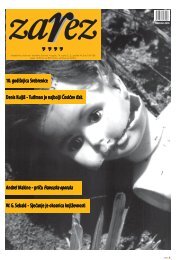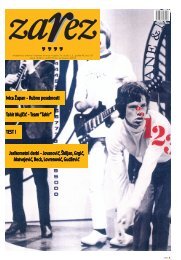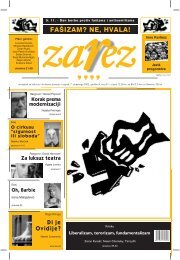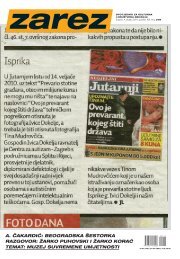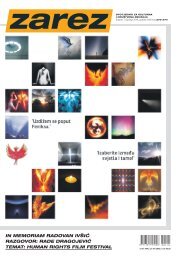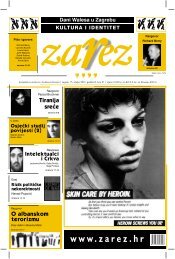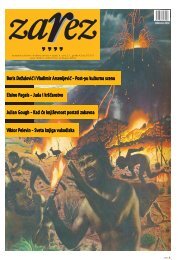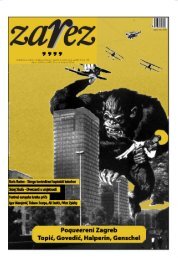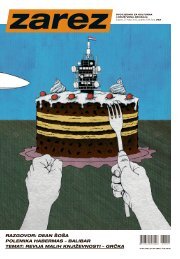Supplement Contemporary Croatian Literature, pp. 15 - 34 - Zarez
Supplement Contemporary Croatian Literature, pp. 15 - 34 - Zarez
Supplement Contemporary Croatian Literature, pp. 15 - 34 - Zarez
- No tags were found...
You also want an ePaper? Increase the reach of your titles
YUMPU automatically turns print PDFs into web optimized ePapers that Google loves.
II/40, 12. listopada,,,. 23Igor ŠtiksCastle in Romagnapublished by Durieux, Zagreb, 2000.gor Štiks’ novel is a deceptively ordinarypiece of reading, with a short,simple and open structure andtwo relatively “familiar” and parallel storiesthat melt into one. We could call it a lovestory, or a historical piece, or simply a topicalstory, but whatever we call it, we aredealing with a text that has been tailoredby a steady hand (and head) of a sophisticatedauthor. We should also mention thatCastle in Romagna is Štiks’ first work offiction…Štiks simply and clearly expands on theJurica PavièiæA Sunday Friendpublished by Znanje, Zagreb 1999he novel opens with a seriesof murders that are conceivedas a riddle. The killeralways leaves behind a particularmessage and a carefully arrangedmurder scene, with a dead body atits (symbolic, not geometrical)center. The framing method of thispsychopathological game eventuallybecomes more transparent to thereader than to the team of crime investigators,but the final solution still takesus by surprise without resorting to cheapgimmickry. Pavièiæ skillfully makes the sinistergame of the killer just one of the branchesin the storyline. Others lead ustowards the key contract of sevenpartners in dubious business...The detective, who is naturallythe main character, moves in a typicalprofessional, private and emotionalcontext. His last name isBarbir (we never find out his firstname), he is a youngish, recentlydivorced man who is carrying ontwo affairs: one is a budding romance,while the other is almostover. His police partner is a more traditonal,older, heavier man. The cinematic genrestructure is compensated by the serious, penetratingdescription of the social contexttypical for the late ‘90s... The political dimensionof the story is not just a "dressing"; itroots Pavièiæ's fiction deeply into <strong>Croatian</strong>reality. This crime story could not have possiblycome to life anywhere else but here, andthat’s more than we could say for much ofthe regular genre production. Pavièiæ capturesthe foreboding atmosphere of Splitin the '90s, and its social setting convincinglytranscends mere fictional scenery...Vedrana Martinoviæhistorical trauma of an individual who hasbeen denied any possibility of control overhis own life. He draws very direct parallelsbetween historical events, individual andcollective paranoia, political and romanticpassions from ancient and more recent history,both dominated by practically the samelexis, same mental code, and same fetishes.He combines the archaic/poetical discourseof Renaissance with the lexicon ofthe socialist-realist authoritarian mentality,spicing it up with the commentaries andobservations of our own era, the era of ironyand distance, fast moves and fast emotions,fast wars, fast food and fast motion,in the spirit of a digest epoch that increasinglyresembles something out of a comicbook.Castle in Romagna is a democraticbook. It speaks democratically about theirreparably despotic nature of the Homosapiens. The structure of the book is neitherepical nor unrestrained nor emotional,on the contrary, it a<strong>pp</strong>ears as a deliberatelyskeletal structure that allows the reader toimprint something of his/her own story. Itallows the reader to “write in” what s/hewants and can, to show the marks of timeand history. This book encourages readersto recognize what they are. The readers arefree to enrich it with their own experience,knowledge, or poetics, or they can reducethe book to a sketch, a croquis, if that fitstheir psychological profile better. Castle inRomagna tells a story of great passion in adispassionate, calm, almost absentmindedmanner. Like our era, it is callous.We must face the fact that what we havehere is a new, different aesthetic and emotionalsensibility, and I am sure that we canlearn something from it. Igor Štiks’ generationalready sees history (including recenthistory) as something that passed themby. Perhaps they don’t sense it yet, or maybethey just don’t know it, but “sins of fathers”always have to be repaid. In the fettersof 20th century global trauma, thisstuporous generation is dealing with itselfand its times the best way it can, protectingitself from pain. Maybe Castle in Romagnais a way, a first step towards teachingthis generation that there is a better, lessradical way. Perhaps, and maybe this iswhat Igor Štiks’ book is about, there isnothing more valuable than we are, thaneach individual person. Maybe we shouldrealize that all that drivel about the need tosacrifice for “higher goals” or “in the nameof higher goals” is just empty talk – empty,but lethal.Daša DrndiæMarinko KošèecThe IslandUnder the Seapublished by Feral Tribune, Split, 1999emands of chronological contextualizationwill probably leadto overlooking playful juxtaposingof extremely different stylistic registersthat Marinko Košèec employs in hisnovel The Island Under The Sea, focusinginstead on the war elements in Košèec’sfiction. Admittedly, Košèec is thechronicler of war, and with The IslandUnder theSea, he hasconsiderablystrengthenedthe corpus ofsubversive<strong>Croatian</strong> warfiction publishedin the'90s.WhileKošèec successfullyprovidesa newperspectiveon <strong>Croatian</strong>War of Independence,what is even more precious ishis ironic view of war events (the usualexcuse that the war is too recent to writeabout does not a<strong>pp</strong>ly to Košèec’s writing).However, the socio-political dimensionof the novel is not the onlyreason for its relevance. Košèec is thefirst author to ironize the turbo-folk variantof <strong>Croatian</strong> nationalism, althoughthat’s not his only target: he also ironizesthe idea of united Europe, feminismand French national narcissism (withspecial emphasis on its most dangerousderivative: Lepenism). He also settlesthe score with theoretical and criticaldogmatism of <strong>Croatian</strong> literary scene.(...)The Island Under the Sea is a Bildungsnovel with a highly picturesque structure.Vivid narration helps the reader toclosely follow the narrator's spiritualmetamorphosis. (...)One of the more charming featuresof the book is caricatural portrayal offamous heroes from <strong>Croatian</strong> politicaland literary scene (where the su<strong>pp</strong>osedmonumentality of many contemporaryfiction writers melts with suspicious easeunder the fiery gaze of our literaryrookie). Longevity of this novel is allbut guaranteed thanks to the way inwhich the author arranges the semanticnet of his motives throughout the book,thus multiplying meanings on every turnand creating the impression of continualnarrative flow. (...)The Island Under the Sea stands outamong more celebrated names of <strong>Croatian</strong>contemporary fiction as a genuinebreath of fresh air: it combines fun, intellectuality,sensitivity and topicality.This book was obviously written with agreat deal of relish, and I feel safe inpromising the same enjoyment to everyreader of Košèec’s new novel.Andreja GregorinaSlavenka DrakuliæAs If I AmNot Therepublished by Feral Tribune, Split, 1999hat redeems the novel As If I AmNot There is the author’s sensitiveand slightly sardonic understandingof the role ordinary "things"play in woman’s life. This is especiallyvital in view of the fact that the novelwas inspired by journalistic researchand data collected for the book on wartestimonies by victims of mass rape(from the victims’ standpoint, of course).That is also why the novel was "almostimpossible" to write.But what was "almost impossible" toshape into a journalistic discourse (asthe author herself has said), in the novelbegins and ends in Caroline's Hospitalin Stockholm, during March 1993.Drakuliæ begins the story with motivesof hatred and dreams of revenge, andwraps it up at the moment when herheroine lets go of hate and revenge andfeels the first signs of forgetting... Thestory is based on author’s journalisticresearch: the description of the centralevent in thenovel – rape ofthe main character– hasbeen adoptedfrom the author'sinterviewwith the actualrape victim,that is, fromthe authenticaccounts. Atthe same time,the novel keepsup a constantdialogue with writers of literatureabout concentration camps (JorgeSempurn being the most obvious influence).The third major influence comesfrom an unexpected source: contemporaryHollywood imaginarium orcontemporary media images of theworld. This excessive media literacy inDrakuliæ’s novel is precisely the reasonwhy the scenes of violence don’t seemtoo credible. After all, the heroine ofthe novel is a typical protagonist ofDrakuliæ's oeuvre: an urban girl obsessedwith "female objects" and the worldviewborrowed from women’s magazines...Gordana CrnkoviæRobert PerišiæFeel Free to Spit onWhoever Asks About Uspublished by Konzor, Zagreb, 1999e all know how tiresome the talkof “generations” among <strong>Croatian</strong>writers has become, but there isno doubt that Feel Free to Spit... is abook marked by a particular generation.Perišiæ’s “yearbook” functions as a pointat which many interests and tastes ofcontemporary <strong>Croatian</strong> readers come together.As an editor of a magazine aimed atreaders of a specific generation, Perišiæ surelyknows what his audience needs andlacks. Like other <strong>Croatian</strong> writers who cameto prominence during the nineties, hehas been heavily influenced by the “hall offame” from the literary magazine Quorum,namely such writers like Carver, Bukowski,Ondaatje, Irvine Walsh. Hisstrongest influence remains the genre ofurban landscape fiction. That is not, however,the final destination of Perišiæ's writing.He goes on to explore – in a documentarymanner – the actual social pulse, thesensibility of <strong>Croatian</strong> cities in the postwarperiod, with the attendant postwariconography. You will never catch Perišiætalking about "exotic places like Sumatraand Java" (to quote Ante Stamaæ, a literarytheorist from an older generation) that sopreoccupied older <strong>Croatian</strong> writers; hewrites about post-traumatic stress syndrome,heroin abuse, football fans, interest ratesand sublet tenants. The composite pictureof the literary decade that emergesfrom Perišiæ’s book reveals how much oftheir influences and methods the youngerwriters learned from their predecessors.However, the stable socialist existence ofthe previous generation was lost, so whatpermeates the nineties ficiton is anxietyand a sense of maturity.Feel Free to Spit... consists of twelve stories.Even a casual glance through thebook reveals that Perišiæ knows what hewants to say, but he is less certain of howto say it. All the stories are iconographicallyand thematically similar. As a rule, theydescribe the fragmentation of urban experienceseen through the eyes of a young,passive outsider, surrounded by hypocrisyand corruption, whose resignation slowlypushes him towards the "anything goes"attitude, drugs, exile, street violence, criminalactions, sex. Nevertheless, we cansafely say that Perišiæ is very prolific in findingnew ways of spinning the basically"same" storyover and overagain. He givesa nod to theAmerican traditionof shockingshort storywith a powerfulpunchline andexperimentswith narrativeminiatures. Hedoesn’tshyaway from classicaland completelycoherent,longer types of narration, nor does helack the skill in techniques like stream ofconsciousness, anarrative introspection,punning or interdiscoursive collage.Unlike most "new naturalists", Perišiæ isinterested in the language of the story.That is why his language becomes so interestingfor the readers, too. Perišiæ uses anexciting mixture of colloquial expressionsfrom Split and Zagreb, as well as slang andeven the archaic micro-dialects (whichdoesn’t always work in favor of story’s linguisticbalance). Besides quotations fromdifferent language-orders, it seems that athis heart of hearts what Perišiæ cares aboutthe most is polyphony and interdicoursivestyle, which is why his texts are so rich inheterogeneity and irony.Jurica Pavièiæ




